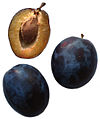Stone fruit
The term stone fruit describes the plant species whose fruits are formed as stone fruits . The inner part of the pericarp is lignified , while the outside is fleshy and mostly juicy.
The “stone” distinguishes these fruits from berries , the fleshy outer pericarp , the pulp , from nuts .
Stone fruits are mainly the fruit species (more or less sweet fruit), so the usual designation stone fruit , although fruit not typically belong to the fruit (eg. As coconut), are among the plants with stone fruit.
Stone fruit is an important supplier of vitamins and minerals, it contains a lot of fructose, few calories and a high water content and a lot of fiber.
Important stone fruits are for example peach , cherry , nectarine , apricot , plum , plum and mirabelle plum . The stone fruit also includes mango and coffee beans.
For a full harvest, at least 25% of the blossoms have to ripen to fruit when they are pollinated, while the corresponding proportion is only 5% for pome fruit .
gallery
See also
Individual evidence
- ^ Food dictionary , accessed on April 2, 2020
- ↑ Stone fruit , accessed April 2, 2020
- ^ Food dictionary , accessed on April 2, 2020
- ↑ Fruit fall: Apple farmers fear for harvest , ORF.at, May 25, 2013.
Web links
- Germany's fruit varieties , an antiquarian specialist book that is around 100 years old, in which more than 300 apple, pear, plum, strawberry, apricot and grape varieties are described with illustrations





